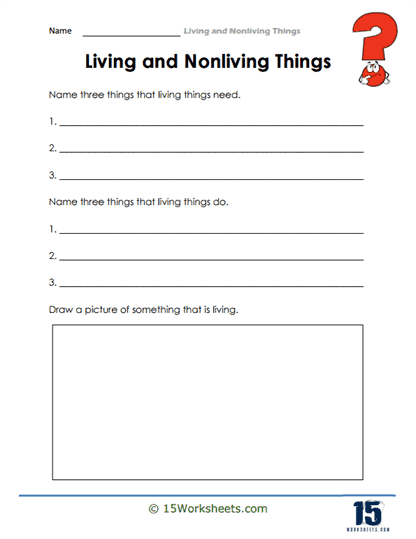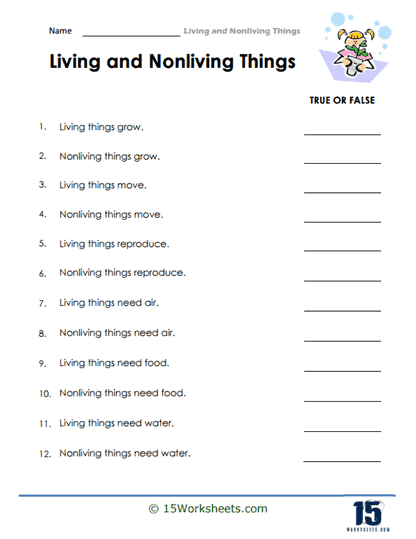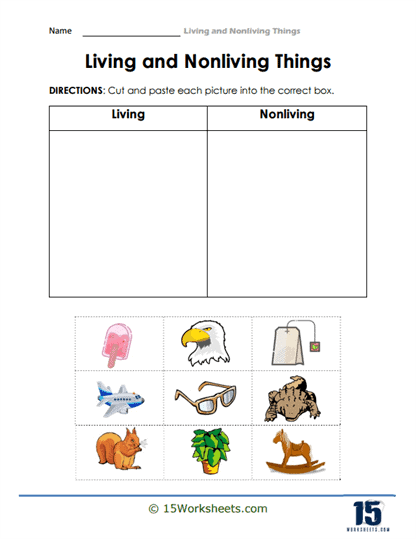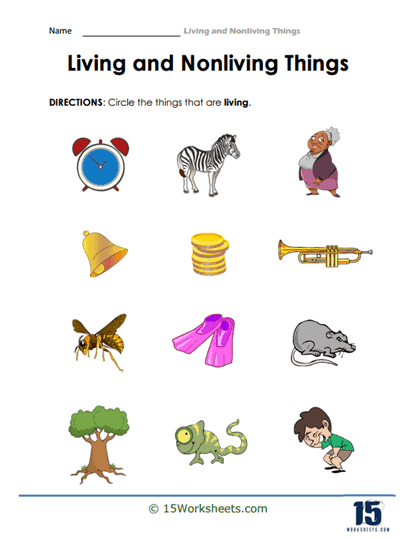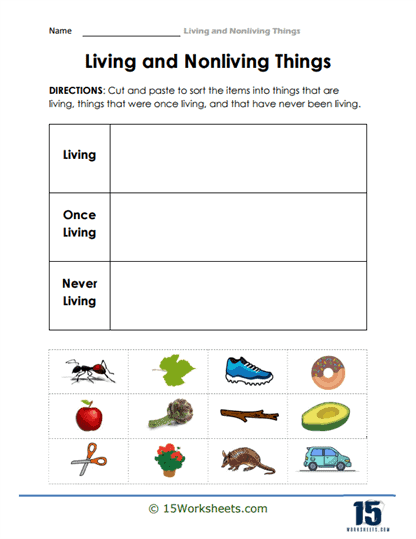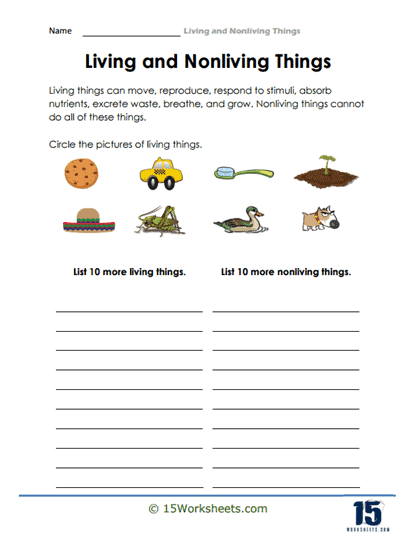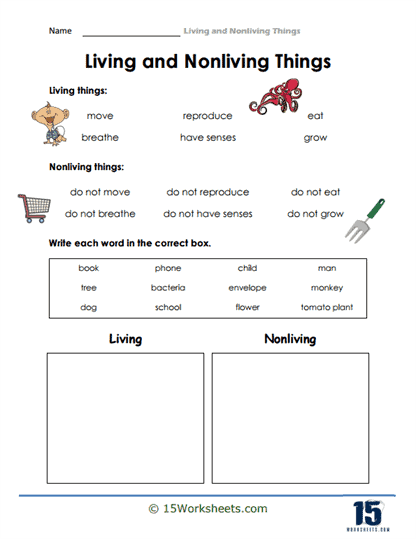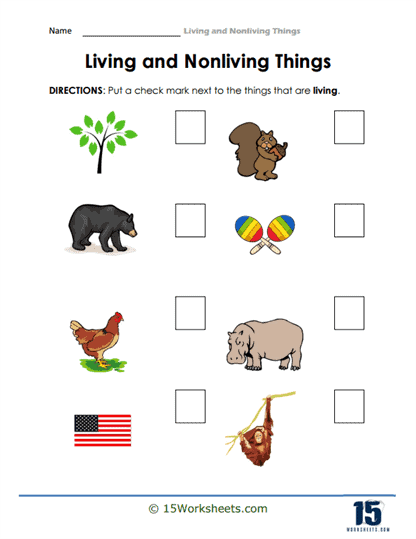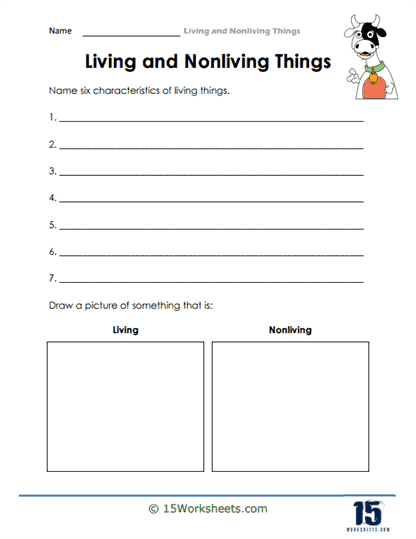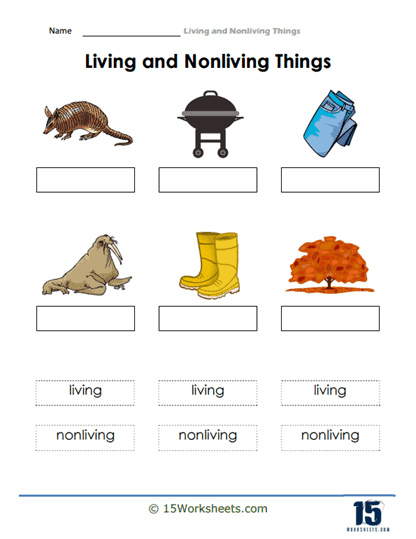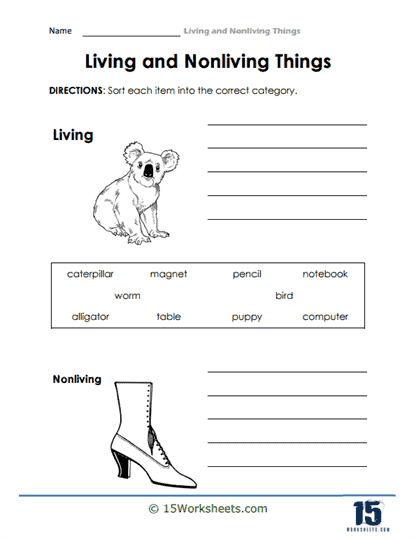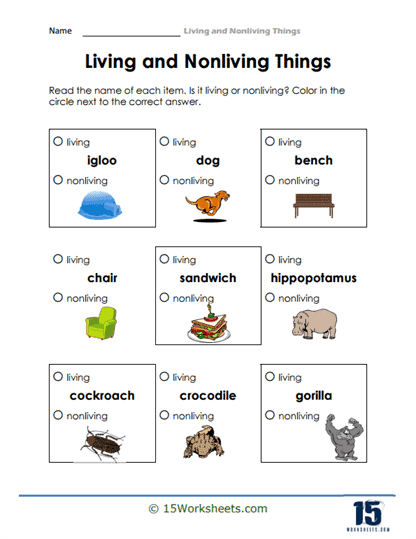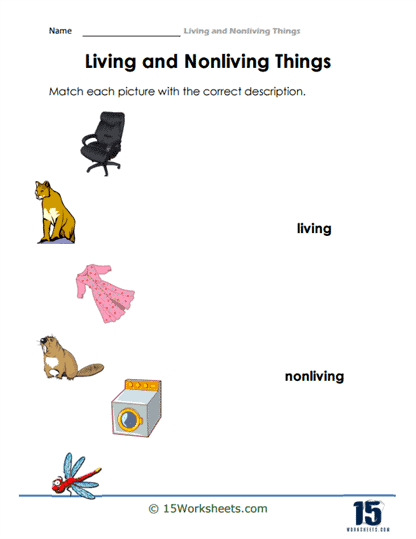Living and Nonliving Things Worksheets
All About These 15 Worksheets
This collection of 15 carefully crafted worksheets offers students a structured and immersive way to explore one of the most fundamental concepts in biology: the distinction between living and nonliving things. At its core, this educational tool aims to guide students through the process of recognizing the characteristics that set living organisms apart from inanimate objects. But what does it truly mean to be “alive”? And how can young learners, some of whom are only beginning to grasp the basics of science, develop a meaningful understanding of life’s complexities?
Each worksheet is designed with both depth and clarity in mind. Students are not just asked to memorize facts; they are encouraged to think critically, to observe the world around them, and to question their assumptions. What makes a flower different from a rock? Why does a dog need food, water, and air, while a chair does not? Through these questions, students begin to uncover the unique needs of living things – things that grow, reproduce, consume energy, and respond to their environment.
One of the key elements these worksheets emphasize is the identification of the needs of living organisms. All living things, from the smallest bacterium to the largest mammal, share certain fundamental requirements for survival. These include the need for nourishment, a way to exchange gases (such as breathing), the ability to grow and reproduce, and the capability to react to stimuli in their environment. By guiding students through this list of needs, the worksheets enable them to make distinctions between living and nonliving things based on specific, observable criteria.
The process of distinguishing between living and nonliving things is not always as straightforward as it might seem. Some objects, like fire, move and change but are not considered alive. Others, like seeds or dormant plants, may not display obvious signs of life immediately but are nonetheless living. This introduces students to the concept that life is not always immediately visible, and that the criteria for life extend beyond mere motion or change. These exercises challenge students to think beyond surface-level observations and to apply a more nuanced understanding of biology.
Creativity is woven into the fabric of these worksheets, allowing students to express their learning in varied and engaging ways. One activity invites students to draw pictures of living and nonliving things. This is not merely an artistic endeavor; it requires them to apply their understanding of life’s characteristics in a practical way. They must decide, based on their growing knowledge, whether the things they draw are capable of fulfilling the needs of living organisms. Such exercises foster not only creativity but also critical thinking, as students are asked to justify their choices.
In addition to drawing, the worksheets may include visual clues-such as photographs or illustrations-that ask students to classify items as living or nonliving. This approach serves a dual purpose: it reinforces the lessons learned earlier while simultaneously enhancing visual literacy. Students learn to pay attention to detail, to scrutinize images for signs of life, and to make thoughtful distinctions. These activities engage multiple senses and learning styles, making the material accessible to a wide range of students.
The versatility of these worksheets is one of their greatest strengths. Designed to cater to students of varying ages and levels of English proficiency, they can be adapted to meet the needs of different classrooms. Whether used as part of a science lesson, for homework assignments, or as independent study materials, they provide opportunities for both guided learning and individual exploration. Teachers can use them to reinforce specific curriculum goals, while students can work through the exercises at their own pace, gaining confidence in their understanding as they progress.
These worksheets do more than just teach science; they also help students build their vocabulary and improve their language skills. As students encounter new terms related to biology, such as “organism,” “stimuli,” and “reproduction,” they expand their scientific vocabulary, which in turn enhances their ability to express complex ideas. This integration of language and science learning ensures that students not only grasp the content but can also communicate it effectively.
Perhaps most importantly, engaging with these worksheets fosters a deeper appreciation for the diversity of life in the natural world. As students begin to understand what it means to be alive, they may start to look at the world around them with new eyes. A blade of grass, an ant crawling on the sidewalk, or the family pet-all take on greater significance when viewed through the lens of biology. The exercises encourage students to see connections between themselves and other living things, promoting a sense of curiosity and wonder about the natural world.
How to Tell If Something Is Living
Determining whether something is living can be done by observing its characteristics and behaviors. To identify if an object or entity is a living organism, look for the following signs:
Cellular Organization
Living organisms are made up of one or more cells. These cells are the basic units of life, containing genetic material and carrying out essential life processes.
Growth, Development, and Reproduction
Living organisms undergo growth and development, changing in size and complexity over time. This may involve cell division, differentiation, and the development of specialized structures.
Living organisms have the ability to reproduce, either sexually or asexually, creating offspring that inherit traits from their parent(s).
Response to Stimuli
Living organisms can respond to external stimuli in their environment. This may include reacting to changes in temperature, light, or chemical signals, and allows organisms to adapt and survive in different conditions.
Metabolism
Living organisms carry out various chemical reactions to maintain life. This includes processes like converting food into energy, synthesizing new molecules, and breaking down waste products.
Homeostasis
Living organisms maintain a stable internal environment, despite fluctuations in their external environment. This involves regulating factors such as temperature, pH, and the concentration of various substances within their cells.
Adaptation and Evolution
Living organisms can adapt to their environment and evolve over time. Through the process of natural selection, populations of organisms develop traits that help them survive and reproduce more effectively in their specific environment.
If an object or entity displays these characteristics, it is likely a living organism. However, it is important to note that some nonliving things may exhibit one or more of these traits (e.g., crystals can grow), so it’s essential to consider multiple characteristics when determining if something is living or not.

